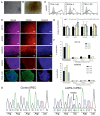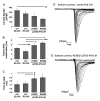The disease-specific phenotype in cardiomyocytes derived from induced pluripotent stem cells of two long QT syndrome type 3 patients
- PMID: 24349418
- PMCID: PMC3859612
- DOI: 10.1371/journal.pone.0083005
The disease-specific phenotype in cardiomyocytes derived from induced pluripotent stem cells of two long QT syndrome type 3 patients
Abstract
Long QT syndromes (LQTS) are heritable diseases characterized by prolongation of the QT interval on an electrocardiogram, which often leads to syncope and sudden cardiac death. Here we report the generation of induced pluripotent stems (iPS) cells from two patients with LQTS type 3 carrying a different point mutation in a sodium channel Nav1.5 (p.V240M and p.R535Q) and functional characterization of cardiomyocytes (CM) derived from them. The iPS cells exhibited all characteristic properties of pluripotent stem cells, maintained the disease-specific mutation and readily differentiated to CM. The duration of action potentials at 50% and 90% repolarization was longer in LQTS-3 CM as compared to control CM but this difference did not reach statistical significance due to high variations among cells. Sodium current recordings demonstrated longer time to peak and longer time to 90% of inactivation of the Na(+) channel in the LQTS-3 CM. This hints at a defective Na(+) channel caused by deficiency in open-state inactivation of the Na(+) channel that is characteristic of LQTS-3. These analyses suggest that the effect of channel mutation in the diseased CM is demonstrated in vitro and that the iPS cell-derived CM can serve as a model system for studying the pathophysiology of LQTS-3, toxicity testing and design of novel therapeutics. However, further improvements in the model are still required to reduce cell-to-cell and cell line-to-cell line variability.
Conflict of interest statement
Figures




References
Publication types
MeSH terms
Substances
LinkOut - more resources
Full Text Sources
Other Literature Sources
Research Materials
Miscellaneous

